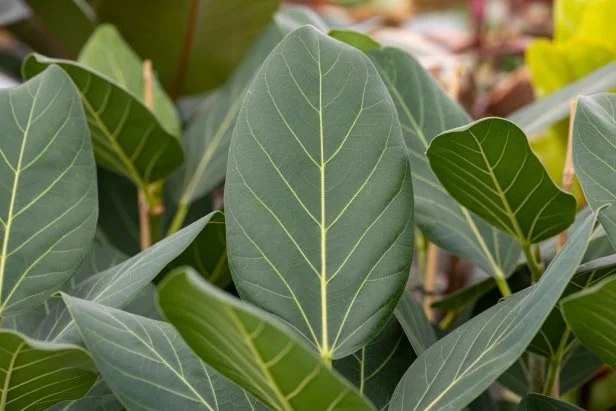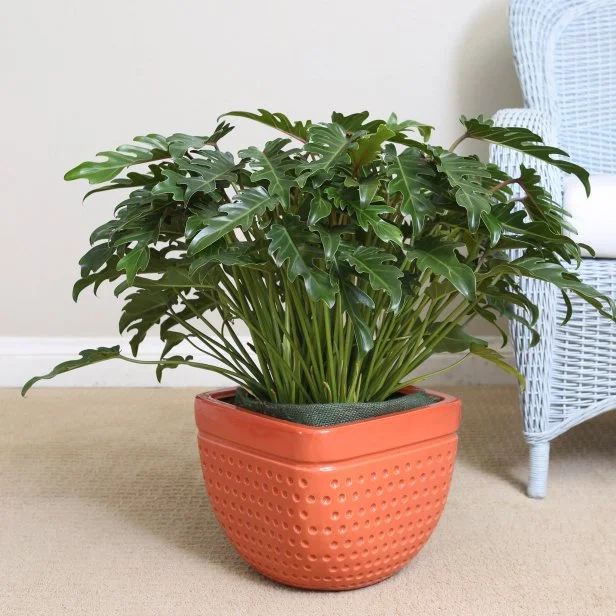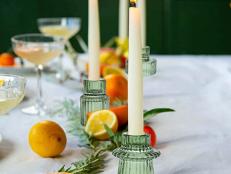Low-Maintenance Alternatives to Fiddle-Leaf Fig
If you’re fighting to keep your fiddle-leaf fig healthy and gorgeous, don’t give up. Find success with easy-growing houseplants that look fabulous.
Let's face it. Fiddle-leaf fig is a striking indoor tree, but it's a diva. It's finicky about so many things: watering, light levels and temperature, to name a few. If you can't get conditions just right, your fiddle-leaf fig can wind up earning its keep as compost.
Instead of struggling to keep a fiddle-leaf fig looking its best, up your houseplant game by growing a low-maintenance beauty instead. There are many other indoor plants that are more forgiving when it comes to care and even more dazzling when it comes to looks. Check out a few of our favorite houseplants.
Ficus 'Audrey'
A cousin to fiddle-leaf fig (Ficus lyrata), Ficus 'Audrey' (Ficus benghalensis 'Audrey') fills the indoor-tree role with ease. 'Audrey' is a fuss-free fig, growing best with bright, indirect light. A spot near an east-facing window is ideal, but a southern or western exposure works, too. Keep soil consistently moist, which is houseplant-speak for "water when the top 2 to 3 inches of soil are dry to the touch."

Shutterstock/Fabrizio Guarisco
Ficus ‘Audrey’ is a variety of Ficus benghalensis, growing 5 to 6 feet tall indoors.
If this ficus has an Achilles heel, it's extreme temperatures. Keep it from 65 degrees to 85 degrees and your plant will thrive. Expect 'Audrey' ficus to grow 5 to 10 feet tall indoors and up to 3 feet wide. Ficus 'Audrey' is an air-purifying plant, making it a great choice for a family room or bedroom. Learn how to grow Ficus 'Audrey'. You can buy Ficus 'Audrey' here.
Burgundy Rubber Tree
Another type of ficus, burgundy rubber tree (Ficus elastica 'Burgundy') delivers stunning color in a fast-growing package. Expect this rubber tree to double in size in a year, eventually growing up to 8 feet tall. It's a beautiful choice for an indoor tree, unfurling leaves that shift from crimson to a deep shade of green that's nearly black. Leaves have a waxy sheen that adds to the drama.
.jpg.rend.hgtvcom.616.616.85.suffix/1587500704532.webp)
Costa Farms
'Burgundy' rubber tree can start as a tabletop plant, but ends up a tree, growing up to 8 feet indoors.
Burgundy rubber tree boasts the best leaf color when it receives bright indirect light (near an east-, west- or south-facing window). It tolerates low light, but the deep-green leaf hue will fade.
It's easy to overwater rubber tree, so wait to water until the top 3 to 4 inches of soil are dry to the touch. Mixing orchid bark and/or perlite into a commercial potting mix for indoor plants helps improve drainage. Choose this plant for its easy-care nature and you'll also enjoy its air purifying abilities. You can buy burgundy rubber tree here.
Stromanthe sanguinea 'Triostar'
The name may be a mouthful, but it's worth learning if you want to add some color to your houseplant collection. The common name is 'Triostar' stromanthe, although this beauty is often sold as Tricolor stromanthe. It's a relative to the prayer plant (Calathea), so-called because the colorful leaves fold up at night like hands folded for bedtime prayers. In this folded position, leaves show off pink to maroon undersides.

Monrovia
You won't miss flowers when you grow Stromanthe sanguinea 'Triostar', a tropical with pink, cream and green foliage.
During the day, the variegated leaves lay flat, displaying shades of green, white and pink. Variegation shifts with exposure to sunlight. Brighter light favors a colorful leaf, while low light yields less brilliantly hued foliage. Stromanthe is more of a shrub size, typically growing 18 to 30 inches tall indoors. But place it on a tall plant stand and it can create the vertical interest of an indoor tree.
The trickiest part of growing stromanthe relates to humidity. This exotic beauty prefers high humidity, which is difficult to achieve in winter's dry indoor air. Leaf edges turn brown when humidity is too low. Remedy this by running a humidifier. You can buy 'Triostar' stromanthe here.
Bamboo Palm
Few indoor trees are more beloved than a classic palm-like bamboo palm (Chamaedorea seifrizii). This indoor tree checks all the boxes: It unfurls lavish leaves, purifies the air, is undemanding and doesn't require bright light. In fact, although it grows well near a bright window, it also thrives in the lower light of a north-facing exposure.

Shutterstock/New Africa
For a tough-as-nails palm, try growing bamboo palm (Chamaedorea seifrizii). It can reach 3 to 8 feet indoors.
Bamboo palm is rugged and has few problems. It grows 3 to 8 feet indoors and as wide as the pot will let it. The plant sends up multiple stems, filling a pot to form a grove of greenery. This tropical beauty needs constant moisture, so water it regularly. To avoid overwatering, add orchid bark to a commercial potting mix to provide good drainage for roots.
If pruning is necessary to remove a too-tall or wayward stem, cut stems where they emerge from soil. This palm doesn't produce new shoots from the middle of a stem. You can buy bamboo palm here.
Money Tree
For head-turning good looks, grace your home with a braided-trunk money tree (Pachira aquatica). This striking tree is a feng shui prize, bringing good fortune and positive energy into the place where it grows, or so the legend goes.

thejoyofplants.co.uk
Money tree (Pachira aquatica) is often sold with braided trunks. Remember to turn the plant weekly for even growth, and snip any shoots that emerge along the trunks.
Place money tree in a spot with bright, indirect light (near an east-, west- or south-facing window). Avoid positioning the plant directly in front of a window, because too much sunlight can scorch leaves, creating brown patches. As the name suggests, money tree grows as a tree, reaching 3 to 6 feet tall indoors.
Money tree prefers soil on the moist side, but don't take that as an invitation to water liberally and frequently. Instead, let the soil dry for an inch or two before you water again. Blend extra perlite into your potting mix to keep soil draining well. Money tree is undemanding in terms of care and has few problems. If leaves turn yellow, the plant might need more light or may be overwatered. Brown and crispy leaves signal too-low humidity. You can buy money tree here.
Xanadu Philodendron
This striking plant is more of a shrub than an indoor tree, but its unusual leaf form and glossy leaves make it a solid choice for any houseplant collection. Xanadu (Thaumatophyllum xanadu 'Winterbourn') is the ultimate low-maintenance houseplant, getting by with minimal water. In fact, after watering, wait until soil is 50 percent dry before watering again. In the winter when growth slows, this plant needs even less water.

Costa Farms
Shiny, leathery leaves feature finger-like lobes on easy-growing Xanadu philodendron. This plant is sometimes sold as Winterbourn philodendron.
Keep your Xanadu plant compact and bushy by giving it medium, indirect light. Give it too much direct sun (right beside a window) and the leaves may scorch. Too little sun (in a dark corner) will cause leaf stems to stretch and become leggy. A happy Xanadu fills a 10- to 14-inch pot with a compact, bushy plant that grows 2 to 4 feet tall and wide. It's a good air-purifying plant. You can buy Xanadu Philodendron here.
Corn Plant
If you're looking for a bulletproof houseplant that achieves tree size indoors, consider corn plant (Dracaena fragrans). This stately tropical commonly grows four to six feet tall. Green leaves feature yellow streaks down the center and sprout from woody canes. You'll often find pots of corn plant for sale having several canes per pot, with each cane a different height. The effect is lovely and forms a ready-made forest.

Shutterstock/Anky
Mass cane or corn plants (Dracaena fragrans) are low-maintenance evergreens from Africa.
Corn plants are easy to love and equally easy to care for. They grow best in bright indirect light, but can thrive in low light. Direct sunlight can cause leaf burn. Avoid overwatering by allowing the top 2 to 3 inches of soil to dry out between waterings. Use distilled or filtered water to help keep leaf edges and tips from browning. You can buy corn plant here.
Tips for Success with Growing Indoor Trees
No matter which type of indoor plant you choose — a colorful tabletop stromanthe or a full-on tree-like bamboo palm — improve your chances of success by following a few simple steps.
- Space. Make sure your home has enough room for your plant's mature size. Are ceilings high enough? Do you have enough space for the plant to achieve its full spread?
- Light. Providing adequate sunlight is make-or-break for growing any indoor plant, but especially a tree. If your designated growing area doesn't have enough light, plan to use grow lights.
- Size. Starting with a smaller plant allows it to adjust to your home's growing environment. Buying a smaller plant also saves your wallet, since full-size trees are pricey.
- Pests. If you happen to have a pest outbreak on other plants in your home, isolate them from your indoor tree as quickly as possible. It can be tough to eliminate a pest from a tree that's loaded with leaves.













































